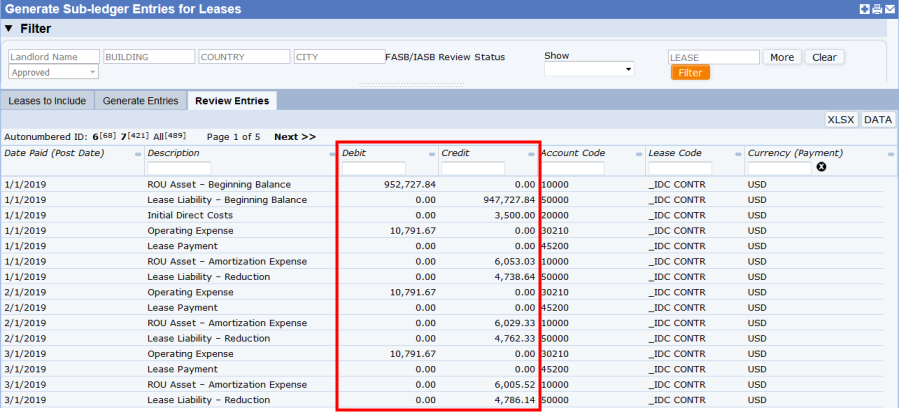Real Property / Leases / Lease Portfolio
Export Lease Costs to the General Ledger
Lease administration often must supply the schedule of charges to accounting that represent:
- the amortized costs of leases
- the gain or loss based on re-evaluation of lease
Typically, lease administration provides this information yearly or quarterly after all lease costs and FASB conditions have been reviewed and all lease classifications have an "Approved" status. Accounting uses this information to inform the quarterly and annual reporting.
Use the Real Property / Leases / Lease Portfolio / Generate Ledger Entries for Leases task to generate this information for your company's general ledger. The system generate subledger entries based on the lease information and the latest amortization schedule and stores the entries in the Lease Subledger Entries (ls_ledger_entries) table. If the ROU Asset has been previously reported and then adjusted through the formal re-evaluation process, the system generates gain or loss ledger items reflecting the restatement.
The previously-defined Real Property / Leases / Background Data specify the account codes and how the routine works with legacy leases.

Procedure
Prerequisite: Real Property / Leases / Background Data
- Load the Real Property / Leases / Lease Portfolio / Generate Ledger Entries for Leases task.
- On the Leases to Include tab, filter for the leases you wish to include. Note that the view is already restricted to show only leases with approved classifications.
- Click on a lease with an approved classification.
- On the Generate Entries tab, specify if you want:
Subledger - Single Entries. To generate "one-sided" sub-ledger entries to be mapped to different accounts by the accounting software on import.
Subledger - Double Entries. To generate "two-sided" subledger entries mapped to counter-balancing accounts. In the above image, the system has generated double entries. That is, if an item is a Debit, the system completes the Credit field with zero; if Credit has a value, the system completes Debit with zero.
- Click the "Generate Subledger Entries" button.
- The routine does the following:
- clears the existing entries in the table for the selected lease or leases, and regenerates them.
- If the lease has been re-evaluated since the date provided with the "Calculate Gain or Loss Since" value, the routine adds entries for the gain or loss on asset re-evaluation.
- On the Review Entries tab, use the buttons to export the data to Excel or csv format in order to share with your finance group.
Analyzing the Exported Data
Once you export the data to Excel, the accounting system can reconcile the difference between what is on the books in the ROU Asset and the lease liability:
- The "ROU Asset - Beginning Balance" and the "Lease Liability - Beginning Balance" start with the same value (that of the sum of the present value of all Net Rent payments).
- Over the life of the lease, the "ROU Asset - Amortization Expense" and the "Lease Liability - Amortization Expense" will both pay down to zero, although at different rates.
For operating leases, the exported values enable the accounting system reconcile the difference between the Net Rent (i.e. actual Cash Payment paid month to month and year to year) and the Operating Expense declared (i.e. the straight-line rent).
- The Net Rent and the Operating Expense total each other over the course of the lease (although their values will differ for each fiscal period).
For finance leases, the exported values enable the accounting system reconcile the different between the Net Rent (Cash Payment) and the amortized components of the lease expense:
- Over the life of the lease, the total Net Rent (Cash Payment) will equal the total of the Lease Liability - Amortization Expense and the Lease Liability - Interest Expense.
See Also
Subledger Report on the Lease Classification Wizard